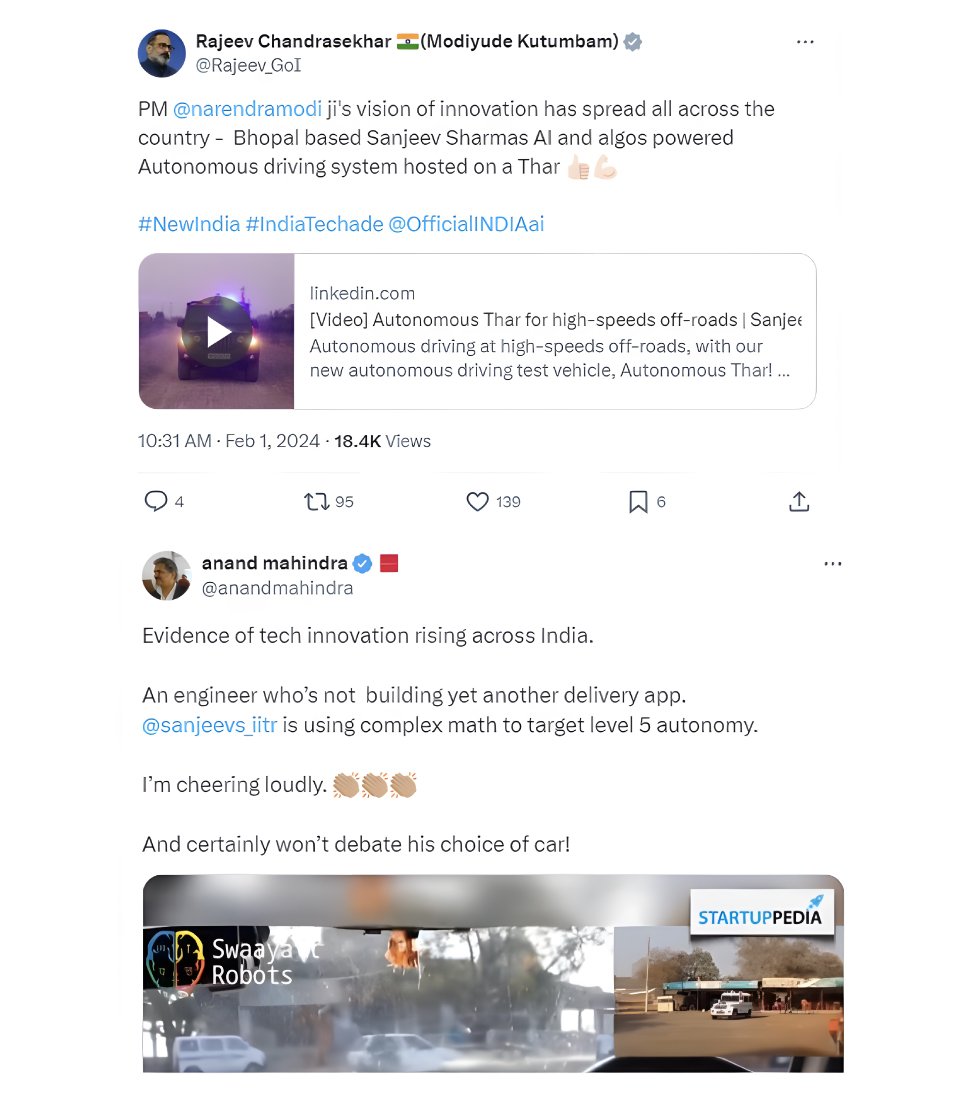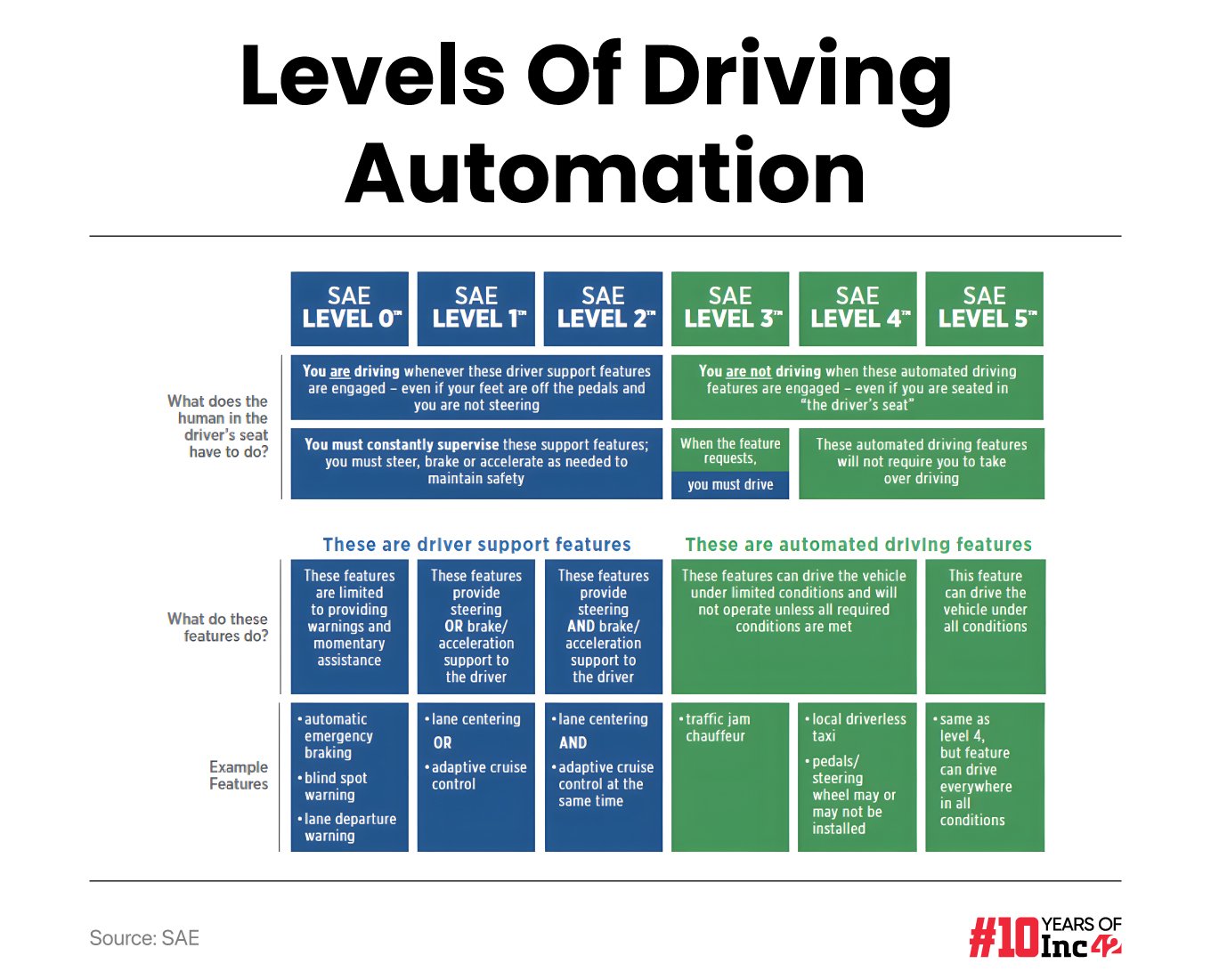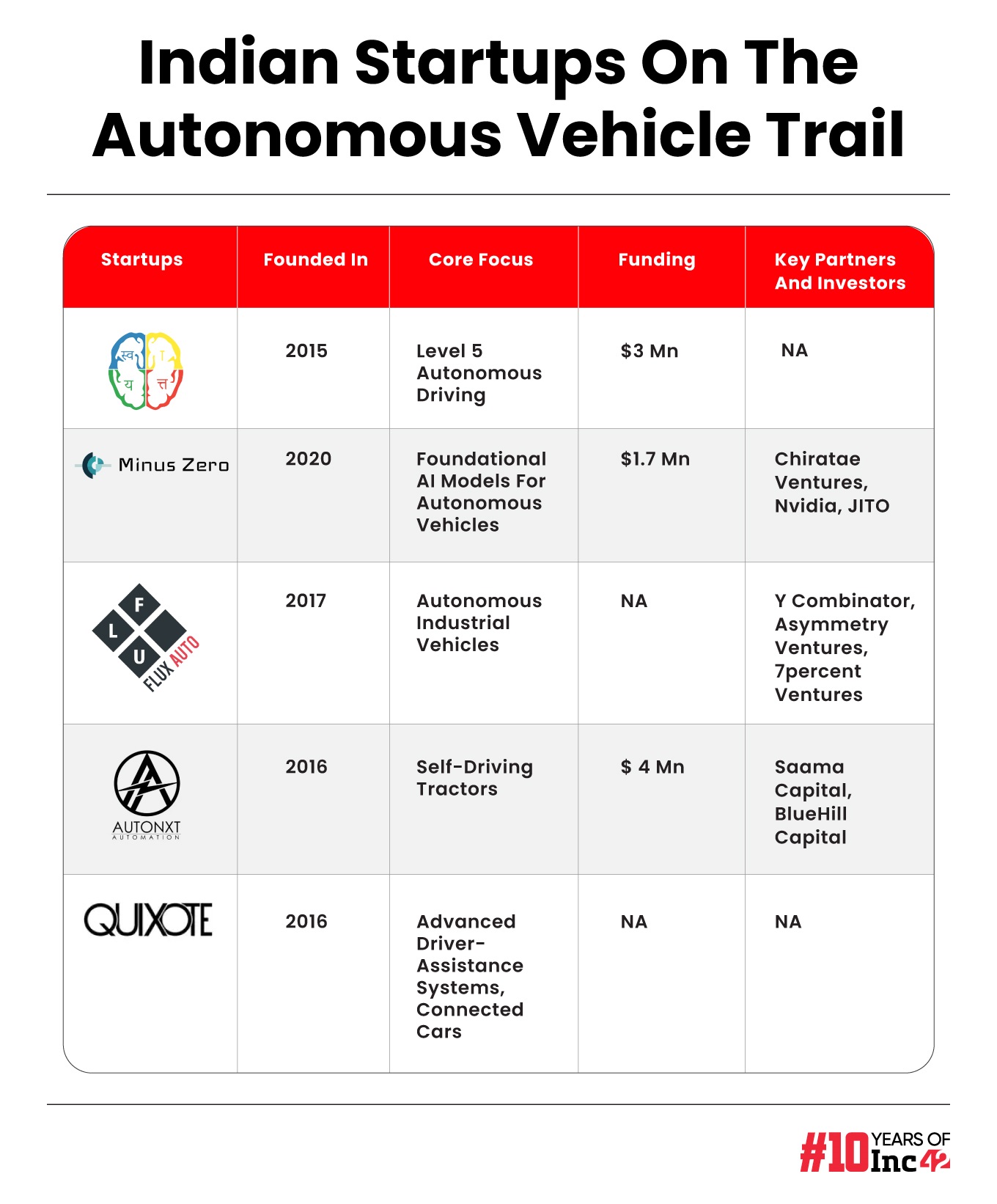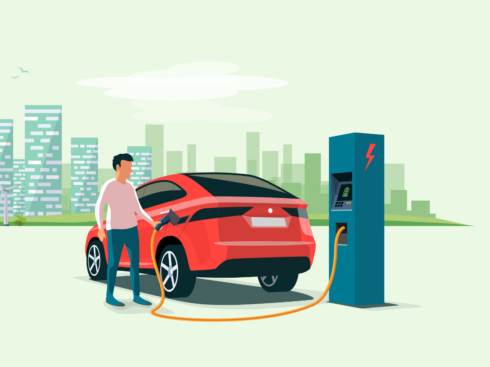While the driverless vehicle landscape is still evolving in terms of laws, cost and technology, industry experts believe Swaayatt Robots’ Level 5 autonomous vehicle driving technology may put India at the forefront of the revolution
Founded by Sanjeev Sharma in 2015, Bhopal-based Swaayatt Robots has built proprietary algorithms and claims to have unparalleled capabilities in autonomous navigation, including on the typically chaotic Indian roads
While multiple Indian startups such as Minus Zero and Flux Auto have been working on self-driving capabilities, Sharma claims that what sets Swaayatt apart is the L5 AV technology capability which has been demonstrated and consume 80% less energy than that of others
Autonomous driving is the future, says a McKinsey report, which claims self-driving vehicles would become a $300 Bn-$400 Bn revenue opportunity by 2035.
In fact, seven out of the top 10 companies by market cap — Apple (till Feb, 2024), Microsoft, Nvidia, Saudi Aramco, Google, Amazon and TSMC — have been actively researching autonomous driving in some capacity.
And that doesn’t even include automobile companies such as Daimler AG, Tesla, Volkswagen and Toyota, all of whom have eyes on autonomous vehicles. Indian OEMs including Tata Motors and Mahindra Auto have stepped into the entry levels of autonomous driving.
But there’s a big chasm between these plans and making autonomous vehicles a reality.
“Neither the technology nor the regulations world over pertaining to autonomous driving are ready. It will take at least 5-7 years for autonomous vehicles (Level 4 & 5) to become a practical solution especially for regions outside US & Europe,” claimed Ashutosh Agrawal, director of product development (AI for autonomous driving) at Bosch.
The German engineering giant lends its autonomous driving-related products to many companies including Daimler AG, VW, etc. Agrawal believes that the entire ecosystem still lacks readiness to pull off fully autonomous vehicles.
For instance, Apple, having spent over $10 Bn and a decade on its autonomous vehicle project, shelved it in February this year. And Bosch’s Agrawal believes that the size of the company does not matter, but rather the focus and expertise that is needed to make self-driving vehicles a reality.
And where the need is technology, startups are likely to have the edge. Despite Nitin Gadkari, the union minister of road transport and highways, stating that driverless cars will never come to India, a slew of Indian startups such as Minus Zero, Flux Auto and Swaayatt Robots are making a buzz, even at this early stage.
The Hype For Swaayatt Robots
While the landscape is still evolving, if you ask industry experts, there is a lot of bullishness around what Swaayatt Robots is doing. The Bhopal-based startup has showcased over 80 demonstrations so far and many believe it is close to showcasing true L5 autonomous driving. Take the below demo, for instance, which drew plenty of media buzz and comparisons between the startup’s founder Sanjeev Sharma and Tesla chief Elon Musk.
What has grabbed the attention of observers is that Swaayatt’s demos are on Indian roads and in offroad conditions, where traffic and road infrastructure are simply not on par with the US or Europe.
For context, Level 5 AVs can run on their own without any humans behind the wheel, a feat which has not yet been achieved by Tesla or indeed any major automotive company. “None of them have been able to achieve what Swaayatt Robots has showcased so far,” added Deb Mukherji MD of Anglian Omega Group.

But Swaayatt and its founder Sharma have flown under the radar, relatively speaking. And given the tall claims by industry insiders as well as the praise from public figures, we wanted to see what the hype around Swaayatt Robots is all about.
As per the Society of Automotive Engineers International, autonomous driving is categorised into six levels, ranging from Level 0 to Level 5. Swaayatt is going for Level 5 autonomous driving, like many other companies, but it is yet to publicly showcase the full capabilities it is trying to build.
Put simply, Swaayatt has demonstrated an autonomous vehicle that’s close to Level 5 in some ways. The company claims to have already tested for over 60,000 Kms across various terrains. These tests were conducted with a human pilot, so there is still some ways to go before the company can claim full L5 autonomy.

Over A Decade In The Making
Sharma’s journey in the autonomous vehicle space began over 15 years ago. The inception of Swaayatt Robots dates back to January 2009, when Sharma was an engineering student at IIT-Roorkee.
“I was studying electrical engineering at that time and was greatly inspired by the videos of MIT’s team at the DARPA Grand Challenge. Those videos sparked a lifelong ambition within me. Solving autonomous driving in the world’s most challenging traffic scenarios became my goal,” he told Inc42.
He began building the mathematical foundation that’s needed for autonomous driving and research towards motion planning, machine decision-making, reinforcement learning and other branches of machine learning.
After graduating in 2011, Sharma continued his research on motion planning (the process of breaking down a desired robotic movement task into discrete and sophisticated motions) and explored algorithms to enable autonomous vehicles and robots to navigate high-traffic environments at Ariel University’s Paslin Laboratory for Robotics and Autonomous Vehicles in Israel.
Having pursued his PhD for almost a year at University of Massachusetts, Sharma deferred his PhD plans to full time pursue the project of autonomous driving.
Between 2011 and 2014, Sharma built a strong knowledge base at global engineering institutions and his research was also published in noted journals. “It was in 2014 when I became fully immersed in this project,” the founder recalled.
From 2015 to 2021, Swaayatt operated on a bootstrapped budget, with Sharma investing INR 80 Lakh into the company. By 2017, the company had showcased almost 36 demos.

The Tech Powering Swaayatt
What goes into building an autonomous vehicle? It comprises sensors, high-end CPUs and GPUs, algorithms that aid in motion planning and decision-making, machine vision capabilities, as well as radars for object detection and tracking, and LiDAR tech for 3D mapping and objection detection.
Swaayatt is using a combination of these sensors — primarily cameras and LiDARs in somecases — to aid in bidirectional traffic navigation, see through dense fog, and enable off-road and night driving.
On the hardware side, Swaayatt has used one of the most cost-effective camera technologies for abstract imaging even as most competitors including Tesla deploy the more expensive LiDAR tech.
It must be noted that Swaayatt has, however, used LiDARs for the 3D mapping and high speed driving algorithms that allow its vehicles to navigate through dense fog.
For years, it has been claimed that autonomous vehicles won’t work in India where road infrastructure is not the best, compared to the western countries. According to the many experts we spoke to, it’s easier to ‘train’ the car using predictive algorithms in the US, UK and parts of Europe given more stringent enforcement of driver safety norms, clear demarcation of lanes and other advantages of infrastructure.
“Our goal is to enable vehicles to navigate not only structured environments and traffic dynamics typical of Western roads but also the chaotic traffic dynamics prevalent on Indian roads. Additionally, our research aims to enable vehicles to contextually understand their environment using only a cellular camera,” Sharma clarified.
Typically, predictive algorithms fail in India due to obstacles such as stray animals, proliferation of manually-operated rickshaws and unpredictability of drivers.
Tesla uses auto regressive reinforcement learning, which relies on a system trained on driver data, which in turn trains the AI driving model. Keeping the Indian roads and traffic in mind, Swaayatt uses reinforcement learning along with human feedback to help vehicles navigate through the traffic without a driver. Sharma claims the company has developed nearly a dozen individual algorithms so far in this regard to aid in autonomous navigation.
“We are primarily an algorithms R&D company. We engage in research across various projects in theoretical computer science and applied mathematics, which are integral to AI,” Sharma added.
One of Swaayatt’s algorithms is the Ellipsoidal Constrained Agent Navigation or ECAN. This is an online path planner that allows solving the problem of autonomous navigation in completely unknown and unseen environments, while modelling the autonomous navigation problem, i.e., avoiding obstacles and guiding the agent towards a goal.
Computation happens on-the-fly as the agent or autonomous driver navigates in the environment towards a goal location.
“The demonstration on November 15, 2017, aimed to showcase our Level 5 automation capabilities. It illustrated the decision-making framework, which encapsulates all the necessary capabilities to ensure Level 5 negotiation,” explained Sharma.
Then, there is the DGN-I, another proprietary algorithm developed by Swaayatt Robots, that simultaneously detects obstacles and segments detected elements on the road, at a speed of 15.66 Bn floating point operations per second.
The Autonomous Competition
Besides Swaayatt, multiple Indian startups such as Minus Zero and Flux Auto have been working on self-driving capabilities. Founded in 2021, Bengaluru-based Minus Zero claims to be close to developing self-driving vehicle platform.
Y Combinator-backed Flux Auto’s core focus is on commercial vehicles such as forklifts, which it enables through an autonomous driving kit.

Globally, companies such as UK-based Wayve could also become formidable competition for Swaayatt in markets such as the US and Europe.
Sharma claims that what sets Swaayatt apart is that it has invented the technology that will power L5 autonomous vehicles in the future, thanks to its approach of building the full stack in-house. He also said that Swaayatt’s vehicles will be capable of navigating freely and the tech can be applied to a range of vehicles.
Sharma insisted that Swaayatt autonomous driving capabilities can work in various challenging scenarios, both on solid roads including narrow lanes and high traffic areas, as well as off-road operations. Further, the energy consumption by Swaayatt Robots are 80% less than that of the competitors, claimed Sharma.
So far, Swaayatt has demonstrated autonomous vehicle capabilities at a relative speed of 60 Kmph, but it is capable of even higher speeds, the founder claimed, adding, “While others have showcased their technology on empty roads, we’ve tackled real-world chaotic traffic situations.”
In comparison with the global counterparts, Randheer Singh, former director of NITI Aayog said, “Swaayatt’s technology is designed for high variability in road and traffic conditions, potentially giving it an edge in environments where other systems like Tesla’s FSD or Google’s Waymo might struggle due to their reliance on well-marked, predictable settings. Waymo, however, excels in urban environment navigation and has reached Level 4 autonomy in limited areas.
Waymo generally leads in terms of navigational accuracy in its operational domains, due to extensive testing and refined sensor fusion technologies. Tesla’s FSD has faced challenges with regulatory scrutiny and reliability concerns. Swaayatt’s accuracy in diverse conditions remains a critical area for observation as they scale.”
Of course, these are still early days in the autonomous vehicle space in India and there’s no certainty around which model is best suited for success. Companies also need to continuously refine their go-to-market strategy and B2B adoption is seen as the primary channel for these early movers.
Swaayatt has also been developing its own map eliminating any dependency on external providers such as Google Maps, HERE or TomTom.
The Roadblocks For Autonomous Vehicles
Just a few months ago, Musk said in a Twitter Spaces interaction that to make fully self-driving tech, companies have to essentially build a rudimentary Artificial General Intelligence (AGI) which is then integrated into a car. Sharma seconded Musk on this.
“You build autonomous driving, you essentially build AGI. This isn’t just my opinion; it’s widely recognised among those who delve into theoretical science and mathematics,” he explained.
But there are multiple challenges that need to be hurdled. This includes technological and regulatory gaps.
For instance in the state of California, driverless cars and robotaxis are allowed basis of permits basis, but the state is mulling stricter norms. This comes after a robotaxi from Alphabet’s Waymo was torched by angry members of the public after a collision with a cyclist. This followed another major incident from earlier where a robotaxi hit a pedestrian and dragged them for six metres before stopping.
A fully autonomous system has to account for all possibilities, including what pedestrians are wearing. A Google Waymo vehicle for instance, stopped, after looking at a pedestrian with a ‘STOP’ symbol on their T-shirt.
Hallucinations on ChatGPT, Google Gemini and other chatbots are alarming, but potential incidents or accidents with driverless vehicles could cost real human lives.
Bosch’s Agrawal said that despite having attained Level 4 autonomous driving, some of the key players went back to ‘Level 2.5’ because of the high costs involved in developing LiDaR-based systems.
Even Tesla is said to have been teaching its algorithms using LiDAR; however, the company might not install LiDAR in the production-ready AVs but would use the learnings only.
The availability of hardware capabilities for L5 AV technology also needs to be proven. Ajesh Saklecha, cofounder of Ozone Motors and TRiDE Mobility said, “So far we have seen multiple demonstrations across the world. These were strictly in lab conditions. Can the same hardware operate for at least 10-12 hours continuously with the same set of performance?”
And then there is the business side of things. There have been umpteen instances of startups getting the tech right but not able to sustain a business, due to failure on the go-to-market side or getting the timing wrong.
Swaayatt will need to answer these questions in the long run, but for now, Sharma is eyeing a fresh fundraise to further improve the technology that allows driving through fog and in rainy weather. The company also has plans to introduce its product in the North American market markets first, where the competition is undoubtedly high and the standards for automotives is far different than in India.
So far, the startup has raised $3 Mn funding at a valuation of around $90 Mn. Sharma claimed that Swaayatt Robots is in advanced stages of talks for a Pre-Series A round worth $10 Mn from Indian and US-based investors. It also plans to finalise a Series A round of $1.5 Bn by the end of FY25, however, a lot has to go right before that happens.
The first product from Swaayatt’s stables is likely to hit the market by the end of 2025, Sharma claimed. The company is targeting OEMs as well as consumers, for whom it is looking at launching an after-market accessory that can be integrated with existing vehicle models.
According to Mukherji and others we spoke with, Swaayatt Robots will be the ChatGPT moment for autonomous vehicles as soon as it launches in the US. As for when the tech will be ready for launch in India, that’s a question no one can answer right now.
[Edited By Nikhil Subramaniam]































 Ad-lite browsing experience
Ad-lite browsing experience